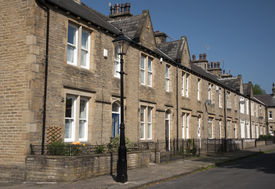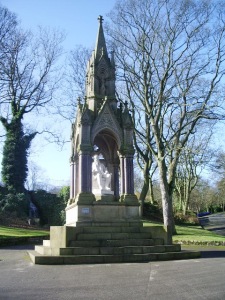20th September 1853. Non-Satanic Mills.
It was Today, after a banquet to celebrate his 50th birthday, that Titus Salt in 1853, opened his new woollen mill.

Salt’s Mills from Leeds and Liverpool Canal. At the time it was said to have the biggest floor-space in the world.
Salt a pioneer of alpaca wool, was the best known manufacturer in the Bradford area, after moving his five mills to one site at Shipley, by the River Aire, the canal and Midland Railway.
He went on to create a model township for his workers-Saltaire- which included bath-houses, institutions and a hospital, but no ‘beer-houses’.(1)
It was the likes of Salt, along with Jedediah Strutt at Belper, Robert Owen at New Lanark, Crossley carpet-makers at Dean Clough, Halifax, and Edward Akroyd MP, who helped to create the industrial wealth, the ‘northern powerhouse’ of 19thc Britain.(2)
Akroyd made worsted material at Halifax, and like Salt created a model town for his workers- Akroydon- with its many institutions, including a school, working men’s college, pension scheme and penny bank.
It was an attempt to bring back some notion of a pre-industrial sense of community favoured by the idealists, Cobbett, John Ruskin and William Morris.(3)
However Akroyd and others were not sentimentalists but hard headed businessmen who realized that giving the workers decent conditions would repay them in productivity.
Also many had a Christian mission towards improving the morality of their workforce, by imposing a drink and gambling-free environment.
Akroyd’s final years were marred by the threat of bankruptcy following an incompetently handled corporate acquisition. His business declined and his Italian Renaissance house Bankfield, was sold to Halifax Corporation and turned into a museum and library.
By 1870 woollen textiles in Britain, were in decline owing to foreign competition. The Salts over-extended, and Titus (junior) had to sell the mill and his house, Milner Field, one of the finest in the North. I was to be pulled down in 1950.
ADDENDA:
Sir Titus Salt (20.9.1803-29.12.1876), was its Chief Constable before Bradford became a borough in 1847, and later MP. At his funeral 100,000 lined the route, not uncommon then for local worthies.
The picture (left), is the canopied Carrara marble statue of Titus Salt, second Mayor of Bradford and erected against his will: ‘So they wish to make me into a pillar of salt’, he said.
(1) Saltaire has F.Derwent Wood’s statue of its founder, in Robert’s Park erected in 1903 on the centenary of his birth and to mark the golden jubilee of his alpaca mill.
(2) Crossley’s survived until 1982.
(3) Ruskin and the others, saw the old rural culture being destroyed by monoculture based on specialisation, factories, economies of scale and divisions of labour.
However ever the idealistic, he took up Cobbett’s idea to found in 1877, a community called St George’s Farm at Totley, near Sheffield, populated by a group of shoemakers who sought self-government. Not surprisingly, the scheme failed.
Ref: wikipedia.org/salts_mill/Image.
Ref: wikipediam.org/titus_salt.
Ref: saltsmill.org.uk.
Ref: common.wikimedia.org/Statue Image.
Ref: googleimages/akroydon.


